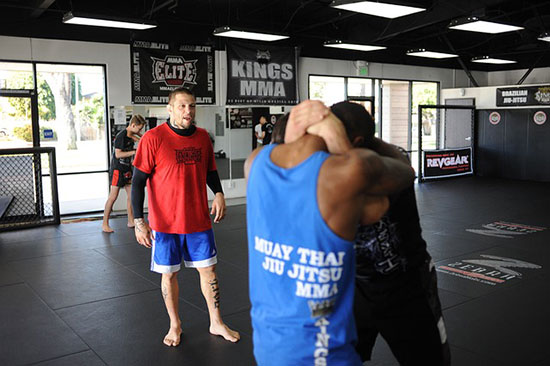Eskrima is a Philippines martial art also known as Kali. The martial art emphasizes using knives, sticks, and bladed weapons for self-defense against the opponent.
The training offers other unarmed defense techniques like using staff, spears, and less complex weapons.
The martial type also focuses on quick reflexes, efficiency, speed, and versatility of combat in addition to good body physique and time factor.
The training includes sparring, partner drills, and solo drills. It is the most efficient and adaptable martial besides its high protectiveness of culture.
Brazilian Jiu- Jitsu (BJJ) is a combat sport and martial art focusing on ground fights and submission holds.
Gracie family developed martial art in the 20th Century in Brazil and modified the Judo and traditional Japanese jujutsu technique, allowing smaller and weaker individuals to defend themselves against a more substantial attacker.
Using joint locks and chokeholds, it uses leverage and techniques to control the opponent. The training method is through sparring and drilling. It is known for upholding respect, culture, and discipline.
Contents
Eskrima advantages
The advantages of Eskrima include the knowledge of high self-defense skills. Since martial art trains practitioners in physical defense using knives, sticks, and other bladed weapons, the outcome is highly effective. Eskrima gives individuals skills to defend themselves in real-life situations.
Another advantage is that it enables good physical fitness. The Eskrima training is physically demanding and, thus, promotes healthy physical fitness.
Another significance is Eskrima promotes cultural appreciation. Eskrima is the most critical Philipines culture. Thus, training promotes cultural appreciation.
Eskrima disadvantages
- Even with the numerous advantages, Eskrima training is associated with disadvantages.
- Injury risk. The nature of the training could cause many injuries if proper safety is not considered. Handling bladed weapons with less care could result in severe physical injuries.
- Time and commitments. Like any other training, Eskrima requires the practitioners to dedicate more time and commitments for improvements to be seen, which is limited to people as the demand for daily activities grow.
- The application of Eskrima is minimal as not all self-defense requires weapons, or there might be a lack of weapons at the time.
BJJ advantages
BJJ is a stress relief exercise. Ground fighting relaxes you and could be the most effective way to fight stress.
Additionally, the training is enjoyable; thus, many people find themselves active by challenging their mental and physical strengths.
Another advantage is that it is a self-defense mechanism. Using leverage and body position to attack an opponent makes BJJ a practical self-defense skill.
Finally, it promotes physical fitness. The exercise during training involves strong body movements, improving physical fitness.
BJJ disadvantages
- BJJ is a physical martial art requiring more time and commitment. Training requires physical attendance to improve the skills unavailable to many people.
- BJJ is expensive. There is a need for uniforms and other protective equipment, which are expensive to purchase, making BJJ unaffordable to all.
- The risk of injury is another disadvantage. Just as with any other martial art, BJJ is characterized by injuries such as bruises and bone breaks. Wearing protective gear and proper training can lower the risks of injuries. However, accidents could still occur.
Differences between Eskrima versus BJJ
Despite having some similarities, Eskrima and BJJ possess differences. First, the training methods differ.
While Eskrima involves sparring using sticks, and knives, in addition to exercises and drills, BJJ involves grappling solo or with a partner in uniform.
Another difference is the martial art origins. BJJ originates from Brazil, while Eskrima has a Philippines origin.
At the same time, Eskrima techniques involve joint locks, chokes, and throws. In contrast, BJJ’s techniques are strikes, blocks, and disarms.
Similarities between Eskrima and BJJ
Despite Eskrima and BJJ having different origins and focusing on different training, they have similarities, such as:
- Self-defense skills. Both martial arts provide practitioners with practical techniques for neutralizing and controlling attackers.
- Another similarity is cultural promotion. BJJ has a strong cultural heritage in Brazil, Eskrima bears that of the Philippines, and both promote their different cultures during practitioners’ training.
- The two martial have similar outcomes; therefore, all practitioners, whether from BJJ or Eskrima, have the potential to fight the opponents.
Closing thoughts
BJJ and Eskrima are essential martial art training. Practitioners acquire similar skills during the training necessary for daily activities such as self-defense.
Eskrima uses grappling, while BJJ uses striking. However, the two offer almost similar training outcomes and are more physical and harmful as they use armed weapons for defense.





